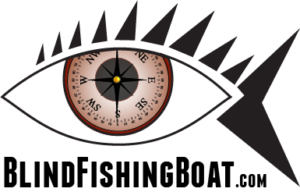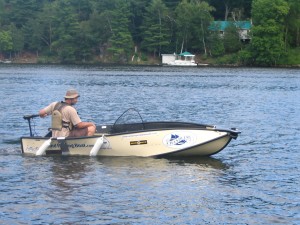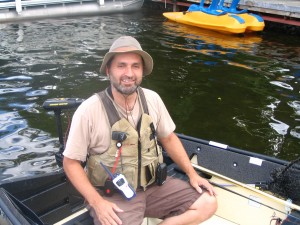Blind Fishing Boat Trials of HumanWare’s New Breeze Talking GPS
In late July 2008 my wife, Kids and I set off for Desert Lake, located just north of Kingston Ontario, for a week of camping and sea trials of the Blind Fishing Porta-Boat. I was more than just a bit excited about this set of trials as it was to involve a pre-release version of the new Breeze talking GPS system HumanWare kindly agreed to provide me ahead of their expected fall public release.
We set up camp at Desert Lake Family Resort and Bret and Sally Coleman, owners and operators of the facility, made sure we were ideally situated (i.e. a playground for the kids 20 meters in front of our site, and the docs about the same distance behind). The kids were happy and so was I. The only thing working against us was the continuously variable weather which saw thunder storms rolling through daily.
Having received the Breeze the day prior to our departure, I commenced my familiarization with the unit by recording various landmarks and routes around the campground. Creation of landmarks and routes is quite simple and involves only minimal key strokes. The unit itself is also leaps and bounds ahead of HumanWare’s Trekker with respect to usability in that everything is now contained within one reasonably sized package with large well defined keys.
My guide dog Maestro introduced a variable to the trials that took me several days to sort out. As those of you who use guide dogs can appreciate, once a dog knows a route, he/she can pretty much follow it without a lot of input from the handler. Thus, under normal conditions, the Breeze’s primary benefit was confirming where I was on the main road that snaked its way through the campground by means of announcing the different landmarks I saved as points of interest.
The first route I recorded on the Breeze with my wife as the guide started at our trailer and ended at the forest bordering the campground. Later that day I repeated the same route on my own, but when I went to back-track, Maestro took a different route back to the trailer without my knowledge. In spite of warnings coming from the Breeze, I remained oblivious to the fact that we had merged on to a second road that also went through the campground and rejoined our initial road just prior to our trailer.
When Maestro chose the fork to the right instead of following the road back the way we had come, Breeze announced, “turn at 8: o’clock”. Thinking that this was an anomaly, I continued forward where upon Breeze then announce, “turn at 6: o’clock”. I then turned around with Maestro, walked back up the road about 20 paces, turned around again, at which point Maestro then decided to follow our original route and all was then good with the Breeze. Not having realized that there was this alternative fork to the right in the road, I wrote the entire episode off as an anomaly.
The next day it happened again, only this time I kept walking thinking that the Breeze will eventually correct itself. It instead began giving me messages such as, “turn back to return to the route”, which is the message it’s designed to give once you have strayed more than 50 meters from your original pre-recorded route. Still thinking the device was suffering from some sort of internal anomaly, I kept walking and after a couple hundred meters or so I merged back on to the original road at which time the Breeze began reporting messages such as, “continue straight, next instruction in 22 meters”. I was able to return to the trailer without further incident, but my faith in the new Breeze had been seriously undermined.
The third time I experienced the return journey anomaly, I was able to get to the bottom of my dog’s trickery by retracing our route after the Breeze began announcing that I needed to turn back. By feeling the grassy edge along the side of the road with my foot I was able to find the point where the two roads forked. If it hadn’t been for the Breeze, I never would have known I was following two different routes. With my faith in the Breeze restored and with the weather showing signs of clearing up, I immediately set to work assembling the Blind Fishing Porta-Boat so I could commence my trials on the water.
I learned two key lessons from my preliminary ground trials of the Breeze. One, the Breeze won’t necessarily announce the instant you depart from a pre-recorded route, and two, finding out exactly where you departed from the route isn’t possible. This isn’t so much a flaw in the Breeze as it is a limitation of the public’s level of access to GPs data.
(Photo of Lawrence heading out in his Porta-boat to go fishing.)
Using the Breeze on the water proved quite reliable. Once I had created my landmarks with my wife I was able to navigate independently in straight lines much as I had with the Trekker. Since the electric motor on my boat has a top speed of about 7 kph, (a good walking pace), I had little difficulty maintaining the minimum speed required to generate useful GPS data.
Care still needed to be taken to ensure that straight line navigation between any two landmarks on the water could be undertaken without encountering obstacles such as a point of land or a floating raft intersecting the track. Avoiding such obstacles is made possible with the use of talking underwater depth sonar and forward-looking sonar on the bow of the boat such as a Mini Guide or BAT Sonar.
Navigating on the water with the Breeze can be challenging in that Breeze doesn’t provide a steady flow of detailed instructions on the direction to take. When re-tracing routes or navigating to a point of interest, Breeze announces course instructions every ten or so seconds, and provides directional feedback via references to positions on the clock. The Breeze is definitely well suited for walkers of sidewalks and paths where the user can make use of the borders on his/her left and right to maintain a relatively straight course.
Backtracking on the water using the back-track feature never seemed like a necessary option given that water allows you to pretty much travel in straight lines to where ever you want to go. However, when I did choose to back-track my route up until that moment, Breeze did eliminate many of the minor loops and turn-arounds I made when originally recording the route. This meant I wasn’t forced to follow the exact route I had just taken in reverse.
When setting off to navigate to a point of interest or pre-recorded route, Breeze announces the Cardinal compass direction (e.g. north-west) one needs to take when commencing a route. This is useful even though the Breeze is only able to confirm the cardinal course direction you are traveling in after you start moving since GPS can only determine your compass direction after calculating a number of concurrent GPS positions. When on the water, having a talking or tactile compass at hand is still a good idea to keep from heading off in the wrong direction when resuming navigation after a pause. Boats do have a tendency of drifting about.
Recorded landmarks are still only accurate within a range of three meters at best, which means you can be three meters to either the left or the right of a landmark, and since you aren’t told in which direction the landmark resides in relation to your current position, the accuracy is in reality about six meters or 20 feet. This still presents a sizable target area that one needs to explore using means other than the Breeze, and necessitates creating your landmarks for things such as docks, rafts, buoys, points of land, etc. well away from the point of interest itself if you want to avoid collisions with the element in question.
Over-all I’d give the Breeze pretty high marks for its functionality and usability. It seems pretty ruggedized and GPS reception is quick and accurate. HumanWare deserves full points for their taking a clean start in developing this product. It’s obvious they have learned much from Trekker versions one and two, and at the same time, they weren’t afraid to try out a number of radically new concepts.
Until the U.S. military decides to allow pedestrians and the rest of the world to access complete GPS data, us folks with sight disabilities will be obliged to make due with GPS systems that can assist us in navigating from point A to B, but can’t get us precisely to the “door”, or in my case, the dock. Until then, people without functional sight will still need to be able to orient themselves independently. However, talking GPS systems are proving to be quite useful for exploring and learning new environments.
Without talking GPS my ability to navigate independently on the water would be sharply curtailed. Magnetic compass headings have no way of compensating for drift, which means a compass may say your heading north-east and it will be right, but it won’t factor into your course the sideways drift caused from wind or current.
I like the Breeze. It complements my Columbia talking compass nicely, and to the outside observer, it would appear no more out of place on my boat then my hand-held VHF radio. All three devices tuck nicely into the front pockets of my PDF and can be attached by their lanyards to rings on the front of my PDF. Definitely a workable solution for the recreational fisher.



